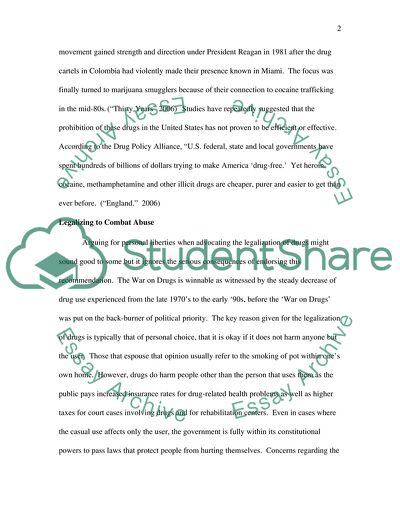
- Home
- Free Samples
- Premium Essays
- Editing Services
- Extra Tools
- Essay Writing Help
- About Us
- Studentshare
- Subjects
- Miscellaneous
- Illegal drugs should be legalized as a means to combat drug abuse
Illegal drugs should be legalized as a means to combat drug abuse - Essay Example

- Subject: Miscellaneous
- Type: Essay
- Level: Masters
- Pages: 4 (1000 words)
- Downloads: 0
- Author: egraham
Extract of sample "Illegal drugs should be legalized as a means to combat drug abuse"
With the number of Vietnam vets returning from war addicted to narcotics, President Nixon officially declared the opening of the War on Drugs in 1971, primarily directed against heroin addiction. The positive effects that were seen coming out of this early stage in the anti-drug movement has been attributed to the fact that a larger proportion of the funding available for this struggle was directed toward treatment, rather than law enforcement. Following Nixon’s resignation, the anti-drug effort gained a new focus, that of enforcing anti-drug laws and collecting the associated fines.
This movement gained strength and direction under President Reagan in 1981 after the drug cartels in Colombia had violently made their presence known in Miami. The focus was finally turned to marijuana smugglers because of their connection to cocaine trafficking in the mid-80s. (“Thirty Years” 2006) Studies have repeatedly suggested that the prohibition of these drugs in the United States has not proven to be efficient or effective. According to the Drug Policy Alliance, “U.S.
federal, state and local governments have spent hundreds of billions of dollars trying to make America ‘drug-free.’ Yet heroin, cocaine, methamphetamine and other illicit drugs are cheaper, purer and easier to get than ever before. (“England.” 2006) Arguing for personal liberties when advocating the legalization of drugs might sound good to some but it ignores the serious consequences of endorsing this recommendation. The War on Drugs is winnable as witnessed by the steady decrease of drug use experienced from the late 1970’s to the early ‘90s, before the ‘War on Drugs’ was put on the back-burner of political priority.
The key reason given for the legalization of drugs is typically that of personal choice, that it is okay if it does not harm anyone but the user. Those
...Download file to see next pages Read More
- TERMS & CONDITIONS
- PRIVACY POLICY
- COOKIES POLICY